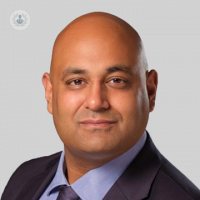FAQs about breast augmentation surgery
Written in association with:Here, in this article below, esteemed consultant plastic, reconstructive, and aesthetic surgeon, Mr Hrsikesa Sharma, provides us with a comprehensive overview of breast augmentation surgery.

What are the different types of breast implants available for breast augmentation surgery, and how do they differ in terms of material, shape, and texture?
Breast implants consist of an outer silicone shell which is filled inside with material. They are filled with either silicone or saline. Most breast implants are made of cohesive silicone gel which makes them resemble breast tissue. Also, if they the cut/rupture, the silicone does not leak out as much as saline.
These days, saline implants in the UK are more commonly used as temporary implants, known as expanders, although formal saline implants are available. Saline implants feel more "fluid filled" and are more prone to rippling.
Breast implants are either round or anatomical. Round breast implants have an equal distribution of silicone in a round shape and my preference is to use these implants more often than not, as they tend to provide more fullness in the upper pole of the breast (cleavage) which is one of the more sought-after requests from my patients.
Anatomical breast implants (also known as tear drop or gummy bear) have more volume based in the lower half of the implant to create more projection on the lower pole. This may be suitable in certain patients. However, in the uncommon event of rotation, anatomical implants may create an unwanted bulge.
Implant surfaces can be smooth or textured in general. Historically, smooth implants were used first but had higher rates of complications such as capsular contracture. This led to the evolution of textured surfaced shells of implants.
Textured implants had, in the past, a reduced number of complications such as capsular contracture and, similar to the groves of a shoe that provide grip, they tended to move around in the breast pocket less than smooth implants.
What factors should individuals consider when choosing the size and profile of breast implants for breast augmentation surgery?
The science of sizing breast implants is evolving. A patient's own breast anatomy is often the most important determinant in the sizing range of implants available to best suit their frame. Bigger is not always better as larger volume or higher profile implants are usually heavier and therefore can potentially affect the normal breast tissue more, resulting in earlier complications.
In my practice, I use a very methodical way to measure my patient's current anatomy that provides a range suitable for their frame and then my patient can chose the projection and volume within those parameters. This enables a simultaneous 'suitable-for-frame' or more natural result whilst also giving my patients choice in their decisions.
What are the potential risks and complications associated with breast augmentation surgery, and how can they be minimised or managed?
Having aesthetic or cosmetic surgery is a serious decision that should not be taken lightly, nor should it be rushed. All operations carry risks. Some of these are generic risks of surgery (bleeding, infection and scarring), and others are specific to the operation (implant capsular contracture and rupture)
For a substantive list of potential complications and an overview of what to expect (timings of recovery and more), please visit my website www.rsasg.co.uk and click on the procedure tab for breast augmentation.
How long does it typically take to recover from breast augmentation surgery, and what post-operative care and precautions are recommended during the recovery period?
Patients have a clear postoperative regimen. The operation is usually a day case procedure and I see my patients after a week, two weeks, and six weeks following the surgery in clinic. A post-operative bra/compression garment is mandatory for six weeks and if all is well at the six-week check, I am happy for them to return to full exercise and normal activity. Again, an overview of the procedure and aftercare regimen is available on my website link www.rsasg.co.uk.
What are the expected outcomes and longevity of results following breast augmentation surgery, and are there any factors that may affect the lifespan of breast implants over time?
It is important to understand that breast implants do not last forever. In the initial stages after surgery, there will be swelling and some bruising which take a few weeks or, in some cases, months to settle. Having said that though, the initial result of the operation is quite apparent after the first few months.
In cases of tuberous breast, there are active changes occur and continue over months or even years with the implant designed to be stretching tissues. The lifespan of the implants depends on a range of factors, some of which depend on individual patient's healing and tissue quality.
Breast implants, on average, last for up to seven to 12 years, though some women may have issues early whilst others have no issues for up to 20 years.
To consult with Mr Hrsikesa Sharma, simply visit his Top Doctors profile today.


